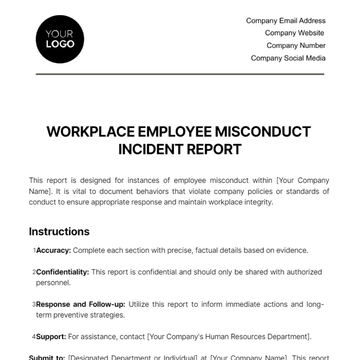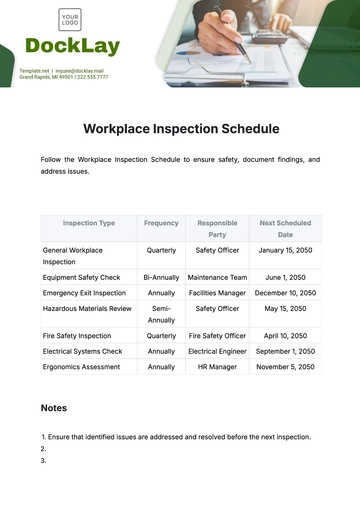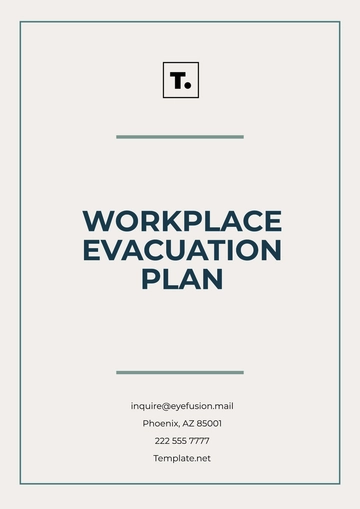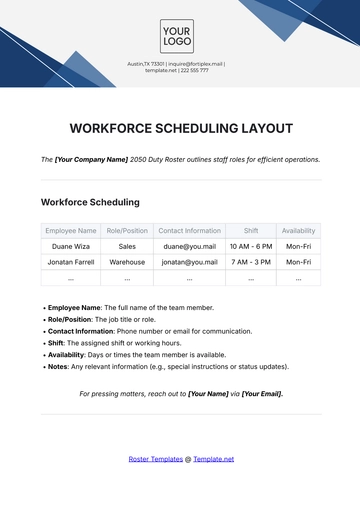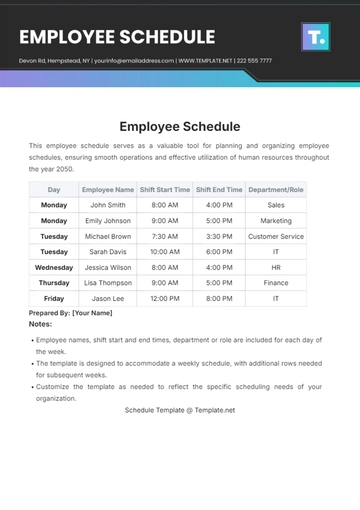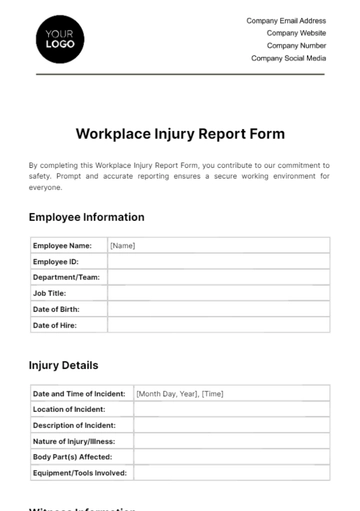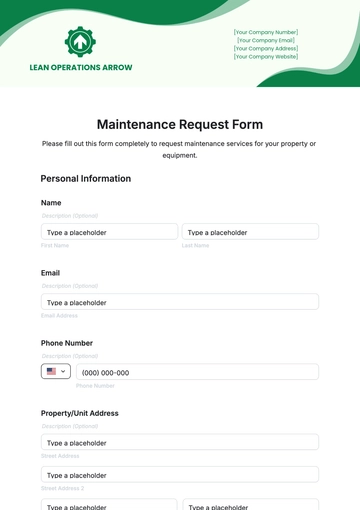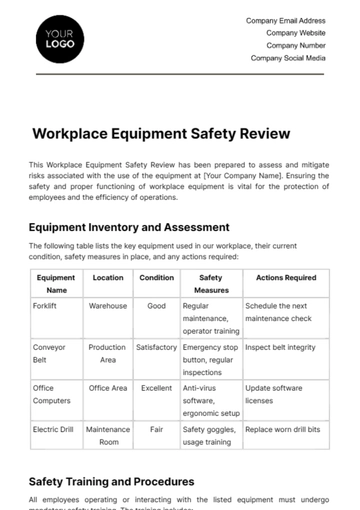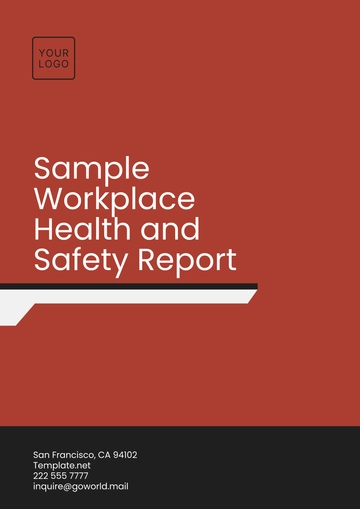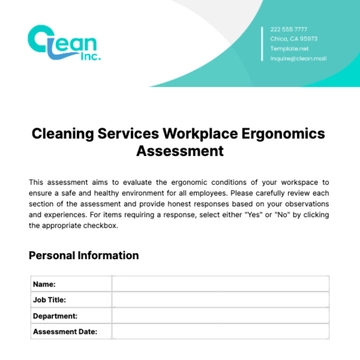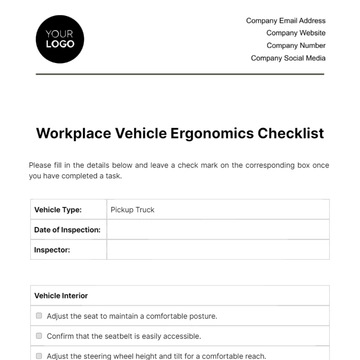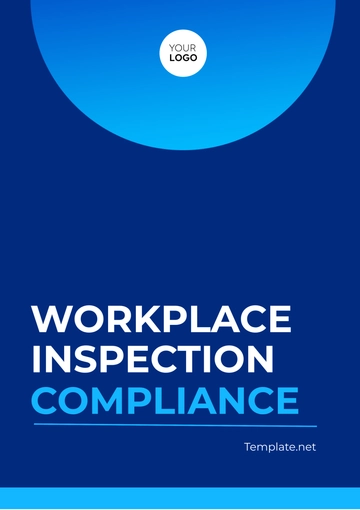Free Workplace Safety Training Study
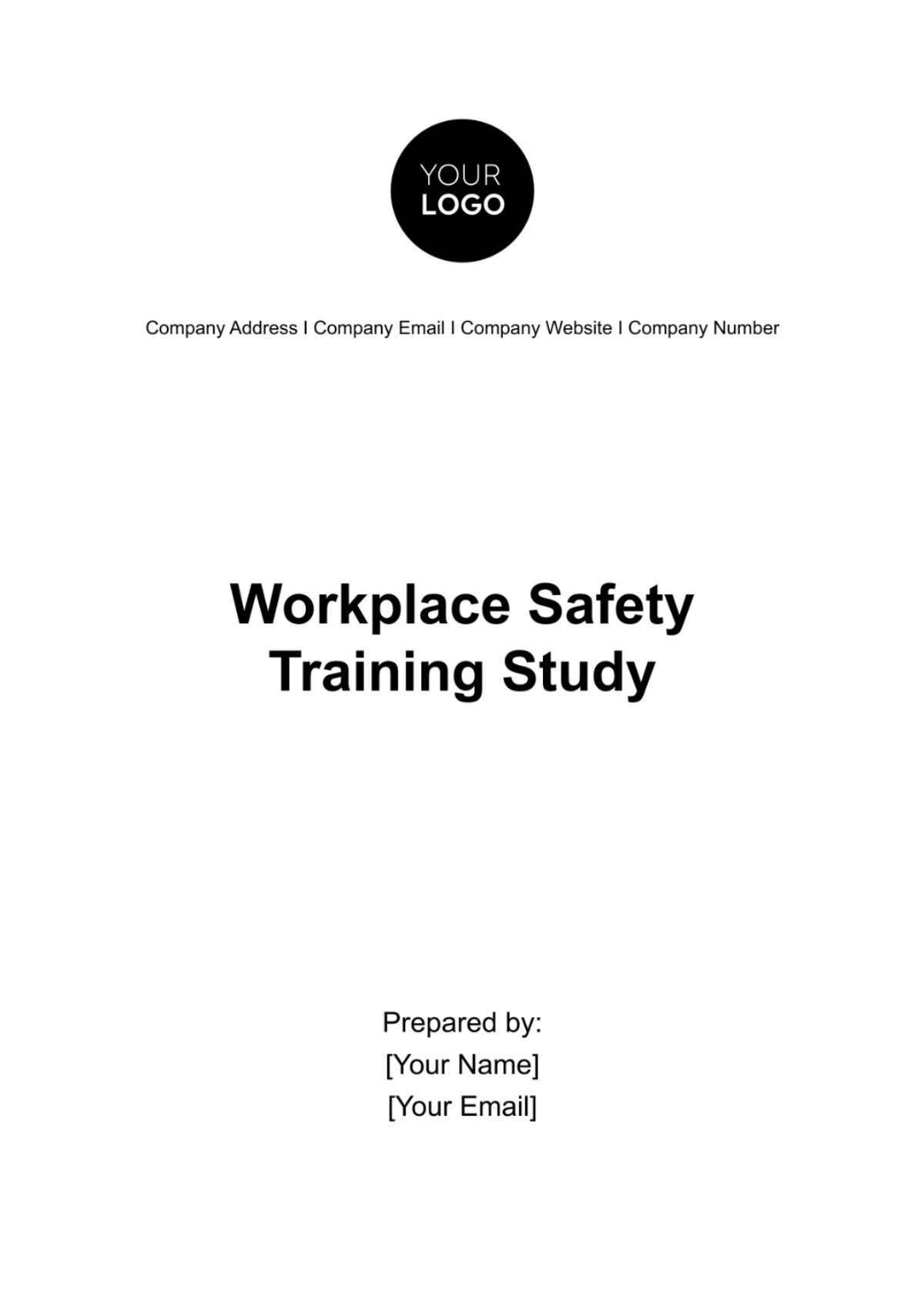
Executive Summary
A. Background
Workplace safety is a top priority for [Your Company Name]. As a responsible organization, we recognize the importance of creating a safe and secure work environment for our employees. This commitment is not only driven by legal obligations but also by our ethical responsibility to protect the well-being of our workforce. In recent years, workplace safety has gained increased attention due to evolving regulations and a growing awareness of the potential risks associated with various industries.
B. Objectives
The primary objectives of this comprehensive Workplace Safety Training Study are to:
Assess the Effectiveness of Current Workplace Safety Training Programs: We aim to evaluate the efficiency and relevance of our existing safety training initiatives. This assessment will help us understand whether our employees are adequately prepared to identify and mitigate potential risks in their work environments.
Identify Gaps and Challenges in the Existing Training Procedures: We will delve into the current training methods, content, and frequency to identify areas that require improvement. By pinpointing these gaps and challenges, we can develop targeted strategies to address them effectively.
Recommend Strategies for Enhancing Workplace Safety Training: Our ultimate goal is to provide actionable recommendations that will lead to the enhancement of workplace safety training within [Your Company Name]. These recommendations will serve as a roadmap for creating a safer and more secure work environment for all employees.
C. Methodology
In order to accomplish these objectives, we employed a rigorous and multifaceted research methodology, which included the following key components:
Data Collection: We gathered data from various sources within the organization, including incident reports, training records, and safety compliance documentation. This information forms the basis for our analysis.
Surveys: We conducted surveys among our employees to gauge their perceptions of the current safety training programs. The surveys were designed to elicit feedback on training content, methods, and overall effectiveness.
Interviews: In-depth interviews were conducted with key stakeholders, including safety officers, trainers, and employees who have undergone safety training. These interviews provided valuable qualitative insights into the strengths and weaknesses of our existing programs.
Benchmarking Against Industry Best Practices: To ensure that our recommendations are aligned with industry standards, we researched and benchmarked against best practices in workplace safety training adopted by leading organizations in our sector.
D. Key Findings
Our comprehensive analysis yielded several key findings that shed light on the state of workplace safety training within [Your Company Name]:
Existing Training Programs Lack Depth and Relevance: A significant portion of our workforce expressed concerns about the depth and relevance of the current training materials. Many employees felt that the content did not adequately address the specific safety challenges they encounter in their roles.
Training Methods Need Diversification: The study revealed that there is room for diversification in our training methods. While traditional classroom-style training remains essential, incorporating interactive and hands-on approaches may lead to more effective learning experiences.
Compliance with Safety Regulations Requires Improvement: While our organization is committed to compliance with safety regulations, there were instances of non-compliance identified during the study. Addressing these compliance issues is crucial to mitigate potential risks and avoid legal repercussions.
Workplace Safety Training Overview
A. Importance of Workplace Safety
Ensuring workplace safety is not merely a legal obligation but a fundamental moral responsibility for [Your Company Name]. Our commitment to maintaining a safe work environment stems from the understanding that the well-being of our employees directly impacts their productivity and overall quality of life.
Employee Well-being: The primary motivation behind workplace safety is the protection of our employees. We believe that every individual has the right to return home safely to their families after a day's work. A safe workplace reduces the likelihood of accidents, injuries, and illnesses, contributing to employees' physical and mental well-being.
Productivity and Efficiency: Workplace accidents and injuries can disrupt operations, leading to downtime and increased costs. By investing in safety training and protocols, we aim to create a work environment where employees can perform their tasks efficiently and without fear of harm.
Reputation and Brand Image: Maintaining a strong commitment to workplace safety enhances our reputation in the industry and among customers. Clients and partners prefer to engage with organizations that prioritize safety, which can lead to increased business opportunities.
B. Legal Requirements
Compliance with local, state, and federal regulations is a fundamental aspect of our approach to workplace safety. As [Your Company Name], we adhere to all relevant laws and standards, including those established by agencies such as OSHA (Occupational Safety and Health Administration). Some key legal requirements include:
Safety Training: OSHA mandates that employees must receive training on specific safety hazards relevant to their job roles. This includes training on handling hazardous materials, operating certain equipment, and responding to emergencies.
Recordkeeping: We maintain detailed records of workplace injuries and illnesses as required by OSHA regulations. These records help us track incident trends and evaluate the effectiveness of our safety programs.
Emergency Preparedness: Regulations require us to have emergency response plans in place, including procedures for evacuations, fire safety, and first aid.
C. Benefits of Effective Training
Effective workplace safety training offers numerous benefits to both employees and the organization:
Reduced Accidents and Injuries: Proper training equips employees with the knowledge and skills to identify and mitigate potential hazards. This leads to a significant reduction in workplace accidents and injuries.
Enhanced Productivity: Employees who feel safe and well-trained in their roles tend to be more focused and productive. A safe work environment fosters a positive work culture and encourages employees to perform at their best.
Cost Savings: Fewer accidents and injuries mean lower healthcare costs, reduced workers' compensation claims, and less time lost due to employee absences. This results in significant cost savings for [Your Company Name].
Methodology
A. Data Collection
Data collection for this study was conducted through a combination of quantitative and qualitative methods:
Quantitative Data: We collected quantitative data by analyzing historical incident reports, training records, and safety compliance documentation. This data provided us with a statistical overview of workplace safety within [Your Company Name].
Qualitative Data: Qualitative data was gathered through in-depth interviews with key personnel and surveys distributed among employees. These qualitative insights helped us understand the human factors and perceptions related to safety training.
B. Sample Size
For surveys, we sampled a representative group of 210 employees from various departments and levels within the organization. This sample size ensures a diverse range of perspectives on workplace safety training.
C. Data Analysis
Data analysis involves both quantitative and qualitative techniques. We used statistical software to analyze quantitative data, including incident rates, injury trends, and compliance rates. Qualitative data from interviews and surveys were coded and analyzed thematically to identify recurring patterns and insights.
Current State of Workplace Safety Training
A. Existing Training Programs
The existing workplace safety training programs within [Your Company Name] encompass a range of topics, including hazard recognition, emergency response, equipment operation, and workplace ergonomics. These programs are typically delivered through a combination of in-person sessions, online modules, and hands-on training.
In-Person Training: In-person training sessions are conducted for critical safety areas such as equipment operation and emergency procedures. These sessions are led by experienced trainers and often include practical exercises to reinforce learning.
Online Modules: To accommodate the diverse schedules of our employees, we offer online safety modules that cover foundational safety topics. Employees can access these modules at their convenience, allowing for flexibility in their training.
B. Training Content
While our existing training programs provide a solid foundation, there is room for improvement in terms of content depth and relevance. Some employees have expressed concerns that certain training materials lack specificity to their job roles. To address this, we plan to customize training content to align with department-specific safety needs.
C. Training Frequency
Training frequency varies depending on the specific safety topic and job role. Some employees receive annual safety refreshers, while others undergo training on an as-needed basis. However, our study has revealed that more frequent safety training, particularly for high-risk roles, may be beneficial in preventing accidents and injuries.
D. Training Methods
Our organization primarily relies on traditional training methods, including lectures, demonstrations, and hands-on exercises. While these methods are effective for conveying essential safety information, there is an opportunity to diversify training approaches. Incorporating interactive simulations, gamified learning, and peer-to-peer knowledge sharing can enhance engagement and retention.
E. Evaluation of Current Training
Evaluating the effectiveness of our current training programs is an ongoing process. We utilize various metrics, including incident rates, safety compliance data, and employee feedback, to assess the impact of training. However, there is room for improvement in our evaluation methods, such as implementing post-training assessments to measure knowledge retention and skill application.
Challenges and Gaps
A. Identified Challenges
Our study has identified several challenges related to workplace safety training:
Diversity of Job Roles: [Your Company Name] employs individuals with diverse job roles, each with unique safety requirements. Ensuring that training programs cater to the specific needs of different departments is a challenge.
Training Accessibility: Providing accessible training options for employees working in remote locations or off-hours can be logistically challenging. Ensuring that all employees have equal access to training resources is a priority.
Compliance Monitoring: While we are committed to compliance with safety regulations, the monitoring and reporting of compliance can be complex. Streamlining these processes is necessary to maintain a consistent safety culture.
B. Training Gaps
The study has revealed certain training gaps:
Inadequate Customization: Some employees feel that training materials lack customization for their specific job roles. A one-size-fits-all approach may not effectively address the nuances of each role.
Limited Practical Application: Training programs could benefit from more hands-on exercises and real-world simulations to better prepare employees for practical safety challenges they may encounter in their roles.
Communication Barriers: Language and cultural barriers can hinder effective training delivery, especially in a diverse workforce. Addressing these barriers is essential to ensure training effectiveness.
C. Compliance Issues
While [Your Company Name] maintains a strong commitment to safety compliance, there have been instances of non-compliance identified during the study. These compliance issues primarily revolve around recordkeeping and reporting requirements. Strengthening our compliance monitoring and reporting processes is critical to ensuring that we meet all regulatory obligations.
Best Practices in Workplace Safety Training
A. Innovative Approaches
Innovation in workplace safety training is key to keeping our programs relevant and effective. We are exploring innovative approaches such as virtual reality (VR) simulations, augmented reality (AR) tools, and gamified learning experiences. These technologies can create immersive and engaging training environments that improve knowledge retention and skill development.
B. Success Stories
Within our organization, there are success stories where improved safety training has led to a significant reduction in accidents and injuries. We have identified these success stories and will document them as best practices to inspire and motivate other teams. Sharing these stories internally can foster a culture of continuous improvement in workplace safety.
Recommendations for Improvement
A. Training Content Enhancement
To address the identified gaps in training content, we recommend the following:
Conduct a comprehensive needs analysis to tailor training materials to specific job roles.
Develop department-specific safety modules that address unique hazards and risks.
Incorporate more real-world scenarios and case studies into training content to enhance relevance and practicality.
B. Frequency and Duration
To improve training frequency and duration:
Implement a tiered approach to training frequency based on risk levels, ensuring that high-risk roles receive more frequent training.
Consider shorter, more frequent safety refreshers to reinforce critical safety information.
Evaluate the optimal duration for each training session to maintain engagement and retention.
C. Training Methods
To diversify training methods:
Explore the integration of interactive e-learning modules that allow employees to learn at their own pace.
Incorporate hands-on simulations and practical exercises to provide opportunities for skill application.
Encourage peer-to-peer knowledge sharing and mentorship as part of the training process.
D. Monitoring and Evaluation
To strengthen monitoring and evaluation:
Implement post-training assessments to measure knowledge retention and application.
Streamline compliance monitoring and reporting processes to ensure accuracy and timeliness.
Regularly review incident data and near-miss reports to identify areas where additional training or procedural changes are needed.
E. Compliance Enhancement
To address compliance issues:
Conduct regular compliance audits and training for personnel responsible for recordkeeping and reporting.
Provide additional training on regulatory requirements to all relevant staff.
Establish clear communication channels for reporting compliance concerns or questions.
Implementation Plan
A. Phased Approach
To implement these recommendations, we propose a phased approach:
Phase 1: | Needs Analysis and Content Enhancement (Months 1-3) |
Phase 2: | Training Method Diversification (Months 4-6) |
Phase 3: | Monitoring and Evaluation Improvements (Months 7-9) |
Phase 4: | Compliance Enhancement and Reporting (Months 10-12) |
B. Timeline
The timeline for each phase will be based on the complexity of the changes and the resources required. A detailed project plan will be developed to ensure a smooth transition to the enhanced workplace safety training program.
C. Budget Allocation
An estimated budget will be allocated for each phase of the implementation plan. This will cover costs associated with content development, technology investments, training materials, compliance audits, and staff training.
Conclusion
This Workplace Safety Training Study has provided valuable insights into the current state of workplace safety training within [Your Company Name]. The commitment to ensuring the safety and well-being of our employees remains a top priority, and this study has reinforced the importance of continually improving our safety training programs.
Through a comprehensive analysis of existing programs, we have identified both strengths and areas for enhancement. It is evident that while our organization has made commendable efforts in providing safety training, there is room for growth and innovation.
- 100% Customizable, free editor
- Access 1 Million+ Templates, photo’s & graphics
- Download or share as a template
- Click and replace photos, graphics, text, backgrounds
- Resize, crop, AI write & more
- Access advanced editor
Enhance workplace safety effortlessly with Template.net's Workplace Safety Training Study Template. This editable and customizable template, powered by our AI Editor Tool, streamlines the creation of comprehensive safety training materials. Equip your team with essential knowledge and practices, ensuring a secure and productive work environment.
